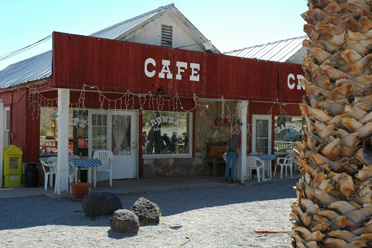Chapter XXV
Ballarat. Ghost Town
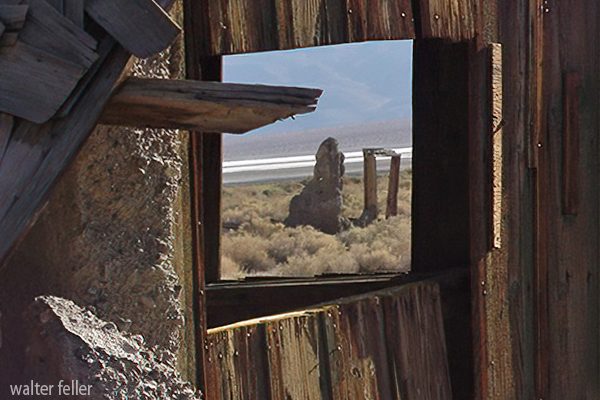
In the early 1890’s gold discovered on the west side of the Panamint in Pleasant Canyon caused the rush responsible for Ballarat. For more than 20 years the district had been combed by prospectors holed in at Post Office Spring, about one half mile south of the site upon which Ballarat was subsequently built. Here the government had a small army post and here soldiers, outlaws, and adventurers received their mail from a box wired in the crotch of a mesquite tree.
The Radcliffe, which was the discovery mine was a profitable producer. The timbers and machinery were hauled from Randsburg over the Slate Range and across Panamint Valley, to the mouth of the canyon. There, under the direction of Oscar Rogers, it was packed on burros and taken up the steep grade to the mine site.
Copperstain Joe, a noted half-breed Indian made the next strike. With a specimen, he went to Mojave where he showed it to Jim Cooper. For five dollars and a gallon of whiskey he led Cooper to the site.
But his deal with Cooper interested me less than the cunning of his burro, Slick. Copperstain strode into a hardware store and asked for a lock. “It’s for Slick’s chain. Picks a lock soon as I turn my back—dam’ him.”
The merchant showed him a lock of intricate mechanism, “He won’t pick this. Costs more, but worth it.”
“I don’t care what it costs,” Copperstain said and bought it. Later he looped the chain around the burro’s feet, fastened the links with the lock and tethered Slick to a stake. “That’ll hold you—” he said defiantly.
The next morning he was back in the store, belligerent. “Helluva lock you sold me. Slick picked it in no time.”
“Impossible.”
“The burro’s gone, ain’t he?” Copperstain bristled, and reaching 176into his pocket, produced the lock. “See that nail in the keyhole? I didn’t put it there. Slick just found a nail—that’s all.” The future of Pleasant Canyon seemed assured and it was decided to move the two saloons and grocery to the flats below, where a town would have room to grow.
When citizens met to choose a name, George Riggins, a young Australian suggested the new town be given a name identified with gold the world over. Ballarat in his native country met the requirement and its name was adopted.
Shorty Harris discovered The Star, The Elephant, the World Beater, The St. Patrick. In Tuba, Jail, Surprise, and Goler Canyons more strikes were made. It is curious that none were made in Happy Canyon.
The production figures of early mines are rarely dependable and the yield is often confused with that obtained by swindlers from outright sale or stock promotion. My friend, Oscar Rogers, superintendent, told me the Radcliffe produced a net profit of approximately $500,000. Less authentic are figures attributed to the following:
The O. B. Joyful in Tuba Canyon, $250,000; The Gem in Jail Canyon, $150,000; and Shorty Harris’ World Beater, $200,000.
Among the noted of Ballarat residents was John LeMoyne, a Frenchman. He discovered a silver mine in Death Valley but the best service he gave the desert was a recipe for coffee. He walked into Ballarat one day and had lunch. The lady who owned the cafe asked if everything suited. “All but the coffee,” John said.
“How do you make your coffee?” she asked.
“Madame, there’s no trick about making good coffee. Plenty coffee. Dam’ little water.”
From one end of Death Valley country to the other, coffee is judged by John LeMoyne’s standard. You may not always get it, but mention it and the waiter will know.
For years LeMoyne held his silver claim in spite of offers far beyond its value, which he believed was $5,000,000. But once when the urge to return to his beloved France was strong and Goldfield, Tonopah, and Rhyolite excited the nation, he weakened and decided to accept an offer said to have been $200,000. “But,” he told the buyers, “it must be cash.”
After a huddle, John’s demand was met and a check offered. John brushed it aside. “But this eez not cash,” he complained. No, he wouldn’t go to town to get the cash. He had work to do. “You get eet.”
Disgusted, the buyers left and John LeMoyne continued to wear his rags, eat his beans, and dream of La Belle France.
A young Shoshone Indian came into Keeler excited as an Indian 177ever gets, looked up Shorty Harris and said: “Short Man, your friend go out. No come back. Maybe him sick.” It was midsummer, but LeMoyne had undertaken to reach his claim.
In the bottom of the valley, Shorty identified LeMoyne’s tracks by a peculiar hobnail which LeMoyne used in his shoes. He followed the tracks to Cottonwood Spring and there found an old French pistol which he knew had belonged to LeMoyne. Convinced he was on the right trail, he went on and after a mile or two met Death Valley Scotty.
“I know why you’re here,” Scotty said. “I’ve just found his body.”
LeMoyne was partially eaten by coyotes and nearby were his dead burros. Though tethered to the mesquite with slender cotton cords which they could easily have broken, the patient asses had elected to die beside him.
And there ended the dream of the glory trail back to the France he loved. Those who believe in the jinx will find something to sustain their faith in the record of John LeMoyne’s mine.
After LeMoyne’s death, Wild Bill Corcoran who had made and lost fortunes in the lush days of Rhyolite, set out from Owens Valley to relocate it. Never a ranting prohibitionist, Bill believed that the best remedy for snake bite was likker in the blood when the snake bit. When he reached Darwin he was not feeling well and stopped long enough for a nip with friends and to get a youngster to drive his car and help at the camp.
It was midsummer, with record temperature but Bill wanted John LeMoyne’s mine. Becoming worse in the valley he stopped in Emigrant Canyon and sent the boy back for a doctor. Bill crawled into an old shack under the hill. When the boy and the doctor came, they found Bill Corcoran on the floor, his hand stretched toward a bottle of bootleg liquor. His soul had gone over the hill.
One after another, five others followed Bill to file on LeMoyne’s claim and each in turn joined Bill over the hill.
LeMoyne’s Christian name was Jean. His surname has been spelled both Lemoigne and Lemoine. The claim from which Indians had formerly taken lead was filed upon by LeMoyne in 1882.
Joe Gorsline, a graduate of Columbia, with a background of wealth, came to Ballarat during the rush, looked over the town. “Wouldn’t spend another day in this dump for all the gold in the mint,” he announced. He had a few drinks, heard a few yarns, eyed a few girls in the honkies. It was all new to Joe, but something about the informalities of life appealed to him and in a little while he was renamed Joe Goose.
Then the town’s constable shot its Judge and Ballarat chose him to succeed the deceased. Not liking the laws of the code, he made a batch 178of his own, which were never questioned. While watching the flow of time and liquor, he "went desert" and put aside the things that might have been for the more alluring things-as-they-are.
When Ballarat became a ghost town, Joe Gorsline took his body to the city, but his soul remained and years afterward when he died, a hearse came down the mountain and in it was Joe Gorsline, home again. He is buried in a little cemetery out on the flat and in the spring the golden sun cups, grow all around and you walk on them to get to his grave.
Adding a cultural touch to Ballarat was an English nobleman who “going desert” tossed his title out of the window, donned overalls and brogans and promptly earned the approving verdict, “An all right guy.” Soon he was drinking with the toper and dancing with the demimonde. Like others, he did his own cooking and washing. He lived in a ’dobe cabin which, because it was on the main street, had its window shades always down.
But there was one little custom of his British routine he never abandoned and this was discovered by accident. He stopped in John Lambert’s saloon one evening before going to his cabin for dinner. He left his watch on the bar and had gone before Lambert noticed it. An hour later Lambert, having an opportunity to get away, took the watch to the cabin. John thus reported what he saw: “He was eating his dinner and bigod—he had on a white shirt, wing collar, and swallow tail.”
Ballarat chuckled but no one suggested a lynching party. They knew how deep grow the roots in the soil one loves. “Maybe,” said Lambert, “that’s why John Bull always wins the last battle. They give up nothing.”
A familiar figure throughout Death Valley country was Johnny-Behind-the-Gun—small and wiry and as much a part of the land as the lizard. His moniker was acquired from his habit of settling disputes without cluttering up the courts. Johnny, whose name was Cyte, accounted for three or four sizable fortunes. Having sold a claim for $35,000 he once bought a saloon and gambling hall in Rhyolite, forswearing prospecting forever.
Johnny advertised his whiskey by drinking it and the squareness of his game, by sitting in it. One night the gentleman opposite was overwhelmed with luck and his pockets bulged with $30,000 of Johnny’s money. Having lost his last chip, Johnny said, “I’ll put up dis place. Ve play vun hand and quit.”
Johnny lost. He got up, reached for his hat. “Vell, my lucky friend, I’ll take a last drink mit you.” He tossed the liquor, lighted a cigar. “Goodnight, chentlemen,” he said. “I go find me anudder mine.”
Johnny had several claims near the Keane Wonder in the Funeral Mountains, held by a sufferance not uncommon among old timers, who respected a notice regardless of legal formalities.
Senator William M. Stewart, Nevada mining magnate, had employed Kyle Smith, a young mining engineer to go into the locality and see what he could find. Smith, a capable and likable chap, in working over the districts, located several claims open for filing by reason of Johnny’s failure to do his assessment work.
It is not altogether clear what happened between Johnny and Smith, but Smith’s body was found after it had lain in the desert sun all day. There being no witnesses the only fact produced by sheriff and coroner was that Smith was dead. Johnny went free. Other escapades with Johnny-Behind-the-Gun occurred with such frequency that he was finally removed from the desert for awhile as the guest of the state.
In a deal with Tom Kelly, Johnny was hesitant about signing some papers according to an understanding. His trigger quickness was explained to Kelly who was not impressed. He went to Johnny and asked him to sign up. Johnny refused. Kelly said calmly, “Johnny, do you see that telephone pole?”
“Yes, I see. Vot about?”
“If you don’t sign, you’re going to climb it.” Johnny signed. He put his gun away when he acquired a lodging house at Beatty, where he died in 1944.
Reminiscing one day in the old saloon he had owned, Chris Wichts slapped the bar: “I’ve taken as much as $65,000 over this old bar in one month.” He had none of it now but in a little cabin in Surprise Canyon with a stream running by his door, and a memory that retained only the laughs of his life, he didn’t need $65,000.
“A city fellow came into the cafe one day. Snooty sort. I told him we had some nice tender burro steaks. He flew off the handle. Said he wanted porterhouse or nothing. I served him. When he finished he apologized for being rude and said his porterhouse was good as he ever ate. I went into the kitchen and came back with a burro shank, shoved it in his face and said, ‘Mister, you ate the meat off this burro leg.’ I thought he’d murder me.”
One day when Ballarat travel was heavy, a dapper passenger dropped off the stage, entered the saloon, bought a drink and paid for it with a $20 gold piece, getting $19.50 in change. When he’d gone, Shorty Harris standing by said: “Chris, that money doesn’t sound right.”
Chris examined it. The gold piece had been split, hollowed out and filled with alloy. Chris worried awhile, then brightened when he noticed his place was full of loafers playing solitaire; pulling at soggy pipes; waiting for a “live one.” “Boys,” said Chris, “old Whiskers ain’t getting much play. Let’s go down and see him.”
Whiskers was his competitor down the street.
A few moments later the bat-wing doors of Whiskers’ place flew open and Chris and his bums swarmed in. Chris laid an arm on the bar. “What’ll it be fellows?” Then he turned to the loafers along the walk “Line up, you guys and have a drink.”
They did and when the drinks were downed, Chris laid the phony gold piece on the bar, received his change and with his crowd returned to his bar. An hour later he was still laughing to himself over the trick he’d played on Whiskers when his own sawed-off doors flapped open and Whiskers barged in, followed by his own mob of moochers. Whiskers ordered for the house and laid down the $20. Chris gulped and gave the change.
That coin circulated in every store and saloon in Ballarat for more than a year. Everybody knew it was phony, but accepted it without question and came to regard it with something akin to affection. Then one day a gentleman in spats came along and the $20 gold piece left forever.
Billy Heider, a slim, genial fellow who had been a hat salesman in a smart toggery shop in Los Angeles came not for gold but to escape alimony. His easy smile masked a stubbornness that nothing could conquer. “... she got a smart lawyer and dated the Judge,” Billy said.
He hung his bench-made suit on a peg, slipped into overalls, cut off one sleeve of his tuxedo to cover a canteen, spread the rest on the floor beside his bed to step on in the morning and so—transition. Eventually he began to prospect, kept at it for 20 years; found nothing, but he beat alimony.
Usually mines were “salted” in shaft or tunnel to separate the sucker from his money, but it remained for a Ballarat woman to find a simpler way.
Michael Sherlock, known as Sparkplug, because of continual trouble with that feature of his automobile, gave me her formula: “She owned a claim in Pleasant Canyon that had a showing of gold. She wanted $10,000 for it. A rich auto dealer came along to look at it. He was worth at least $5,000,000. She told him to take his mining engineer and get his own samples and when he got back she’d have a chicken dinner waiting.
“They got the samples, came down, parked the car in front of her house, got their bellies full of chicken and went back to the city. A couple of days later the millionaire was back. Couldn’t get his money into her hands quick enough. Word went out there would be work enough for all comers and we figured on boom times. But he couldn’t find ore to match her samples.”
“What happened?” I asked.
“While he was eating chicken dinner that night, her Indian hired man went out to his auto and switched samples.”
I asked Sparkplug why he didn’t sue her.
“If you had $5,000,000 would you want the whole dam’ state laughing at you?”
Randsburg, which boomed in the early Eighties as a result of gold strikes in the Yellow Aster, the King Solomon, and later the Kelly silver mine, soon became one of the principal eastern gateways to the Panamint and to Death Valley by way of Granite Wells and Wingate Pass.
A curious story of a man haunted by his conscience is that of William Dooley and told to me by Dr. Samuel Slocum, who had come to Randsburg from Arizona after making a fortune in gold.
A howling blizzard had driven everyone from the streets and the campers in Fiddlers’ Gulch into Billy Hevron’s saloon. Dr. Slocum, lost in the blinding snow and stumbling along the street, felt with his hands for walls he couldn’t see, while a barroom noise guided him to the door.
At the bar he saw William Paddock, mining engineer. “Bill, you’re the man I’m looking for. I can’t find anyone who can tell me how to get to Goler Canyon in Panamint Valley. You’ve been there and I want you to draw me a map.”
Paddock, finishing a drink ordered one for Slocum and introduced him to a man at his side: “This is Mr. Dooley,” Paddock said, and the doctor saw a great hulk of a man with black whiskers, small eyes, and an uneasy look. Before a word was spoken Slocum sensed Dooley’s instant dislike of him.
Slocum ordered a round of drinks. Dooley refused and walked to the farther end of the bar.
Paddock followed Dooley after a moment, talked with him and returned to his drink. He said to Slocum: “I’m in a curious situation. I don’t know much about Dooley, but down in Mexico he saved my life. Now it’s my turn to save his. He just killed a man in Arizona and came here to hide out. I’m taking him to Goler Canyon soon as this blizzard is over. He thinks you are a deputy U. S. Marshal and claims that he has seen you before and that you are no doctor.”
“He may have seen me in Arizona at Gold Hill,” Slocum said.
“The best way I can help you,” Paddock continued, “is to sign the road as I go and after a day or two you can follow us.”
On the day following Paddock’s departure Doctor Slocum set out. The next day he came upon a newly-made grave, outlined with stone. On a redwood board used for the marker was carved this inscription:
“Here lies Bill Dooley who died by giving Wm. Paddock the dam’ lie.”
With no reason to shed tears, the Doctor following Paddock’s signs, reached Goler Canyon, made camp and knowing that Paddock intended to occupy a stone cabin farther up the gulch, he started up the trail. He’d gone only a short distance when he saw Paddock approaching, waving his arms in a signal for Slocum to go back. The Doctor stopped.
When Paddock came down he said, “For God’s sake, Doc, get back to your camp. Dooley is behind that big boulder above us with a Winchester trained on you.”
“Why, I thought he was dead....”
“No,” Paddock smiled grimly. “He worked all night digging that grave. Said it would throw you off his trail. I can’t get it out of his head you’re a marshal.”
Slocum had made a gruelling trip to free and open country and he had no intention of being driven out. “I’ll go up and talk to him,” he said. Paddock warned him that it would be useless and might be fatal, but Slocum insisted and they went up the trail, Paddock going in front to shield him.
Dooley was outside the cabin with a rifle in the crook of his arm, his finger on the trigger.
Slocum was unarmed. He calmly assured Dooley he was not an officer; that he had no intention of disclosing Dooley’s whereabouts, “But this is free country and I intend to stay.”
Dooley’s reaction was a noncommittal grunt. However, violence was avoided. When the Doctor returned to his camp, Paddock decided it would be best to accompany him as a measure of safety. Explaining to Dooley that he would remain with the Doctor to inspect a claim, he remained as a body-guard for three days. On the fourth he went up to the stone cabin and discovered Dooley had loaded his wagon with all the camp equipment and supplies, including a green water keg and left for parts unknown.
Just across the range was Hungry Bill’s country. A year or so afterward Doctor Slocum, crossing the mountains into Death Valley, stopped at Hungry Bill’s Six Spring Canyon Ranch and noticed a green cask. Hungry Bill said that he had found the keg floating on the ooze near Badwater. “Somewhere under that ooze,” Doctor Slocum said, “lies Bill Dooley, his team, his wagon, and its load.”
An interesting character of this area was Toppy Johnson, who scouted for Senator George Hearst and later had charge of copper claims belonging to William Randolph Hearst, near Granite Wells.
While there, Toppy employed Aunt Liza, a negro cook. Aunt Liza came from Randsburg with an enormous trunk. She was a good cook, but an awful thief and nearly everything Toppy owned except the furniture disappeared piece by piece. When his razor vanished he looked through the trunk and found the loot. He didn’t want to lose Aunt Liza, so he removed a few of the more needed things, leaving the rest to be recovered by instalments. Thereafter it was a game of losing and retrieving.
As strange a coincidence as I’ve ever heard attended the end of Toppy Johnson. Sent to Mexico when Pancho Villa was overrunning the country, he fled to Mazatlan when Pancho announced he would shoot on sight both native and foreigners who were not in sympathy with his marauding.
All boats were crowded with refugees, both native and alien, but Toppy was permitted to join the hundreds willing to sleep on deck. Toppy unwittingly chose a spot over the saloon where drunken celebrants soon began shooting at the ceiling.
A shot penetrated the flooring of the craft’s deck and Toppy’s abdomen. An American physician sleeping alongside was awakened by Toppy’s groans, attended him, but saw there was no hope. The physician asked his name, the object being to notify the victim’s relatives.
“If my doctor were only here,” Toppy moaned, “he could save me.”
“Who is your doctor?”
“Dr. Samuel Slocum, of Pasadena,” Toppy said, and died.
The physician was Dr. Slocum’s nephew.
Thirty-four miles south of Ballarat at the end of a narrow canyon leading from Wingate Pass road into Death Valley, one comes upon a breath-taking riot of color. Pink hills. Blue hills. Hills of dazzling white, mottled with black and green. Yellow hills. Maroon and jade hills.
A gentleman of fine fancy and fluent tongue passed that way, learned that under the hills was a deposit of epsom salts. Then he went to Hollywood where salts met money. He talked convincingly of nature’s drug store. “Just sink a shovel into the ground and up comes two dollars’ worth of medicine recommended by every doctor in the country. No educating the public. Everybody knows epsom salts.”
There was no flaw in that argument and Hollywood dipped into its pockets. A mono rail was strung from Searles’ Lake over the Slate Range through Wingate Pass and up the slopes to the pink hills. There rose Epsom City. For awhile the balanced cars scooted along that gleaming rail, bearing salts to market—dreams of wealth to Hollywood.
But the world had enough salts, Epsom City failed. Nothing is left to remind one of the incredible folly but a few boards and a pile of bones. The bones are those of wild burros slaughtered by vandals who in a project as inhuman as ever excited lust for money, went through the country and killed the helpless animals, to be sold to manufacturers of chicken and dog food.
A singular character known as Dad Smith, who had come to California with John C. Fremont was one of the earliest settlers at Post Office Springs. Smith had been a scout with Kit Carson in the Apache wars in Arizona and returned to the lower Panamint in 1860, to hunt gold in Butte Valley, where, nearing 90 he dug a tunnel 100 feet in length. Found there delirious, with pneumonia, by Dr. Samuel Slocum, he was removed to the Doctor’s camp where Mrs. Slocum nursed him through his convalescence. When he recovered he decided to give Mrs. Slocum a token of his gratitude.
At the time, Barstow and Daggett were the most convenient stations for prospectors in the southerly area. At Daggett they likkered at Mother Featherlegs’. At Barstow they bought at Judge Gooding’s store or at Aunt Hannah’s, and drank at Sloan and Hart’s saloon. Dad’s money, as was that of others, was left with them for safe keeping. So he walked every mile of a ten days’ round trip to get a box of chocolates for Mrs. Slocum. A little chore like that made no difference to Dad. He encountered a desert rain and arrived at the Slocum cabin drenched. They persuaded him to remain overnight and led him to a tent.
Seeing that water dripped from Dad’s blankets, Dr. Slocum went for dry bedding. When he returned, Dad had his own bedding spread on the ground. “Here, Dad—take this dry bedding....”
“Not on your life,” Dad said as he crawled into his own. “I’d catch cold, sure as hell.”
Two noted athletes of the period went into the Panamint for a vacation. When they asked for a guide, they were told to get Dad, but after looking him over they decided he lacked stamina, but engaged him when they could find no one else. The route was over the Panamint into Death Valley and back through Redlands Canyon—a trip to test the hardiest.
On the third day Dad returned alone. Asked about his companions, he grumbled: “They’re down and out. Now I’ve got to haul ’em in.”
He took his burros, lashed the victims securely on the beasts and brought them in.
Remembered by oldsters, was Archie McDermot, a big fellow of unbelievable strength who was an all-purpose employee of Dr. Slocum.
While they were camped at Barstow one night, Archie went up town to pass a cheerful hour and during the course of the evening a brawl started and Archie suddenly found himself the object of a mass attack by five burly miners. Archie knocked them down as they came, threw them out and returned to his drinking. The constable went in to take Archie. Archie tossed him through the door. The officer didn’t want to kill him, and collecting a posse of four brawny helpers, tried again. Archie pitched them out.
Being a friend of Slocum, the constable now went to see the Doctor. “Doc, can’t you come down and do something about Archie? Knowing how you need him, I don’t want to kill him....”
Doctor Slocum went, discovered that Archie, after throwing everybody out of the place, had seized the long heavy bar, turned it on its side and was sitting on the edge with a bottle in each hand. Doctor Slocum regarded the wreckage and then Archie. “Good Lord, Archie, what have you done?”
“Nothing, Doc,” Archie said. “Just having a nip. Take one on the house....”
“What about this fight?”
“Fight?” repeated Archie. “Oh, that—some fellows tried to start a little ruckus but I didn’t pay much attention to it.”
But if Archie had no fear of a dozen live men, he was terrorized by a dead one.
Doctor and Mrs. Slocum, with Archie, were leaving their camp in the Panamint. The thermometer under the canopy of the vehicle registered 135 degrees—hot for an April day, even in Death Valley country. As they drove along, the Doctor noticed some clothing on a bush. “Seems strange,” he said. “Let’s look around.”
Archie skirmished through the bushes. Presently he returned, his face white, horror in his eyes. He grabbed the wagon wheel, his quivering bulk shaking the heavily loaded vehicle. “For God’s sake, Doc. Go and look!”
The Doctor saw a sight as pitiable as it is ever man’s lot to see—a young fellow dying from thirst on the desert. His protruding tongue split in the middle. Unable to speak, though retaining a spark of life. The fingers of both hands worn to stubs.
Kneeling, Doctor Slocum asked the victim where he came from; where he wished to go. No sign came from the staring eyes. Finally the Doctor said, “We want to help you. We have water. We’re going to take you home.” At the mention of home, a feeble smile came, and two tears, the last two drops in that wasted body, rolled down his cheeks and dried in the desert sun and then he died. There was nothing to do but bury the body.
“You’ll have to help me, Archie,” the Doctor said.
A look of terror came into Archie’s eyes. “Doc,” he pleaded, “ask me anything but that....”
The man who’d cleaned up Barstow, quailed in superstitious fear at the thought of touching the dead.
They looked around for a place to dig a grave. But the country was covered with malpai and lava rock and they couldn’t dig in it. The Doctor wrapped the body in a piece of canvas and Mrs. Slocum aided in lifting it into the wagon. She drove the team while the Doctor and Archie walked along, looking for loose earth and finally found a spot. Archie dug the grave. The Doctor lowered the body and Archie with shut eyes, filled the grave.
A press story of the finding brought a flood of letters from all parts of the country. Such stories always do. From mothers, wives, sweethearts—but none from men. It’s always the woman who cares.
Such deaths are due to inexperience. This boy had no canteen. Just around the corner of a jutting hill was Lone Willow Spring.
Though scarcely a vestige remains, there was once a town at Lone Willow. Saloons and an enormous dance hall lured the Bad Boys and there the trail ended for scores reported as missing men.
Cyclone Wilson, a nephew of Shady Myrick who built a sizable export trade in gem stones, and for whom Myrick Springs is named, was taking a wagon load of Chinese coolies to work at Old Harmony. All Chinamen looked alike to Cyclone and he didn’t know that these were newcomers. It was his custom to discharge his passengers at the foot of a steep hill near Lone Willow and require them to walk to the top.
As usual, upon reaching this grade he set his brakes and waited for the coolies to get out. None moved, then he ordered them out. The Chinamen sat in stony silence. He repeated the order with no result other than jabber among themselves. Angered, Cyclone reached for his long blacksnake whip. It had a “cracker” on the end of which was a buckshot. With unerring accuracy he aimed the whip at the nearest coolie and overboard he went. The others leaped out and drawing knives from their big loose sleeves, massed for assault.
Cyclone reached for a pistol—always carried on the wagon seat, and started shooting. His toll was five Chinamen.
The cause of the murders, it was later learned, was due entirely to the fact that none of the Chinamen had understood a word Cyclone had spoken.
A Chinaman at Lone Willow, who spoke English made his countrymen bury the dead.
Today Ballarat is a ghost town and soon every trace of it will be gone. Roofless walls lift like prayerful arms to gods that are deaf.
In the late afternoon when the shadows of the Argus Range have crept across the valley, a few old timers come out of leaning dobes and stand bareheaded to look about. The afterglow of a sun is upon the peaks and the afterglow of dreams in their hearts. They people the empty streets with men long dead, some in unmarked graves in the little cemetery on the flat just beyond the town. Some on the trails, God only knows where. These dead they see pass in and out of the old saloons. These dead they hear again. Glasses tinkle, slippered feet dance again.
Tomorrow? Their pale eyes lift to the canyons and though dimmed a little, they see one hundred billion dollars.
What of Shoshone? It remains with changes of course. The shanties hauled from Greenwater have been hauled somewhere else. No longer do I step from my car as I have so often and call to those on the bench. “Move over, fellows” and hear their familiar greeting: “Where the hell you been?”
Instead, I drive to an air conditioned cabin and stroll back to the former site of the bench, so long the social center. There I see a sign over a door which reads, “Crowbar” and I enter a dreamy cavern with dimmed, rosy lights, hear the music of ice against glass and refuse to believe the startling sight of an honest-to-goodness old timer tending bar in a clean white shirt.
Likewise I balk at the white lines I walk between as I cross the asphalt road to the store.
But above Shoshone the same blue skies stretch without end over a world apart, and under them are the same uncrowded trails; the same far horizons for the vagabond’s foot and the peace “which passeth all understanding.”
COPYRIGHT 1951 BY WILLIAM CARUTHERS
Published by Death Valley Publishing Co.
Ontario, California

Ballarat

Post Office Spring
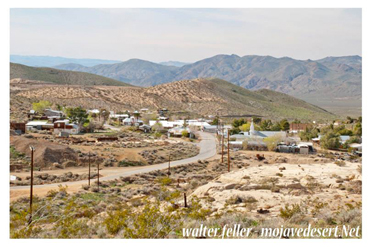
Randsburg
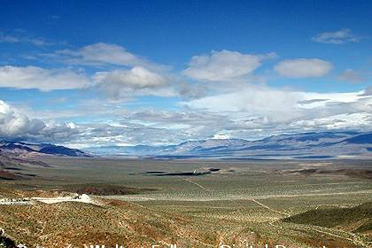
Panamint Valley
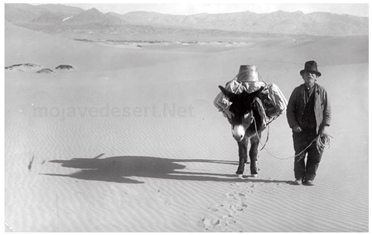
Shorty Harris
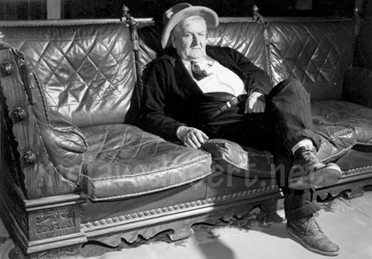
Death Valley Scotty
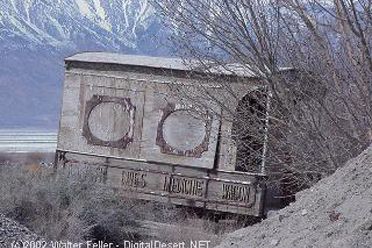
Keeler
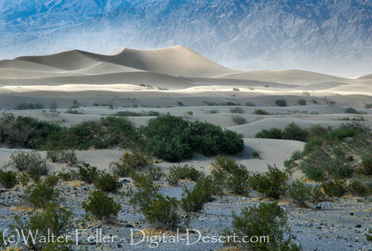
Death Valley
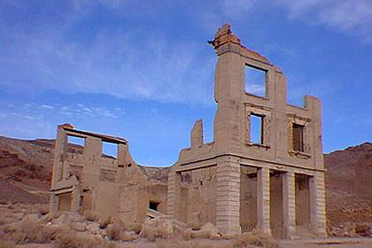
Rhyolite
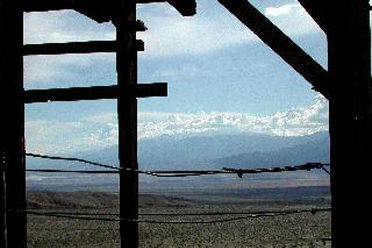
Keane Wonder

Beatty, Nv.

Badwater
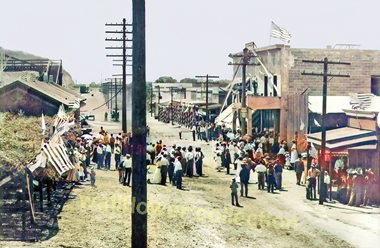
Barstow
v2.jpg)
Daggett
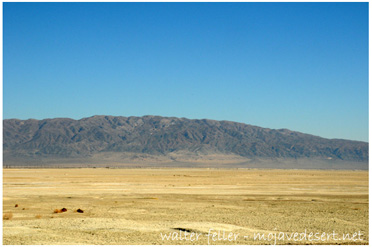
Searles Lake

Shoshone
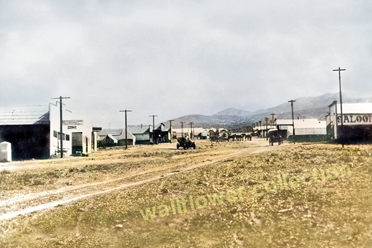
Greenwater
